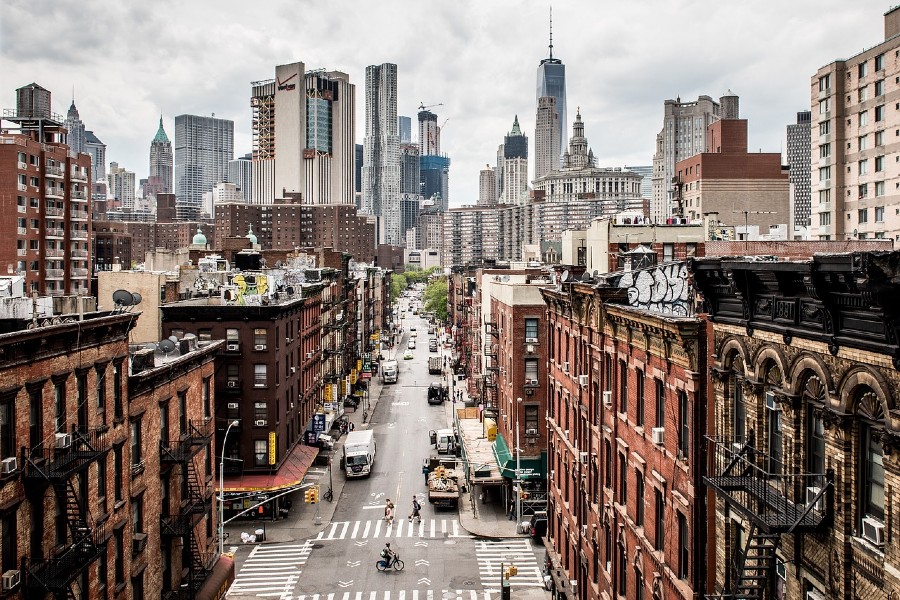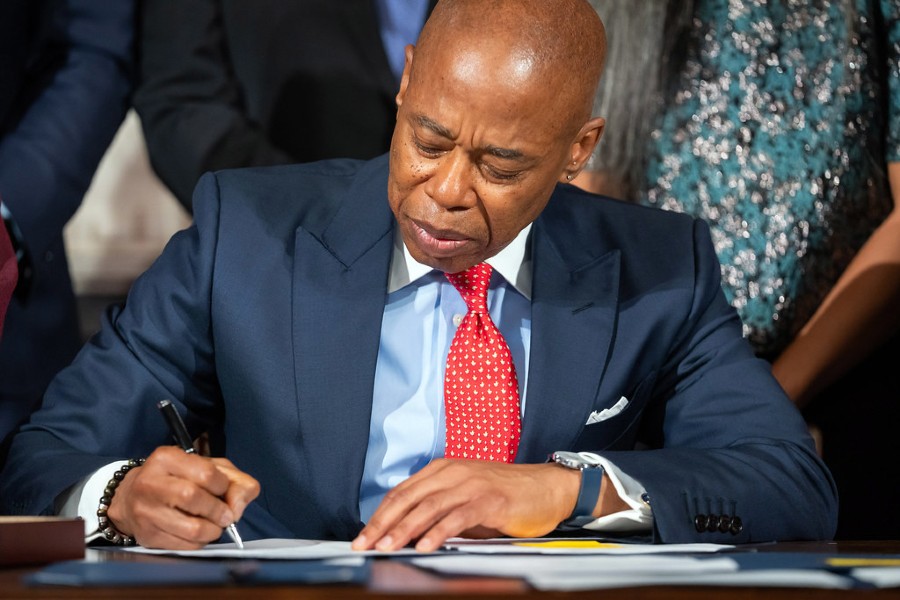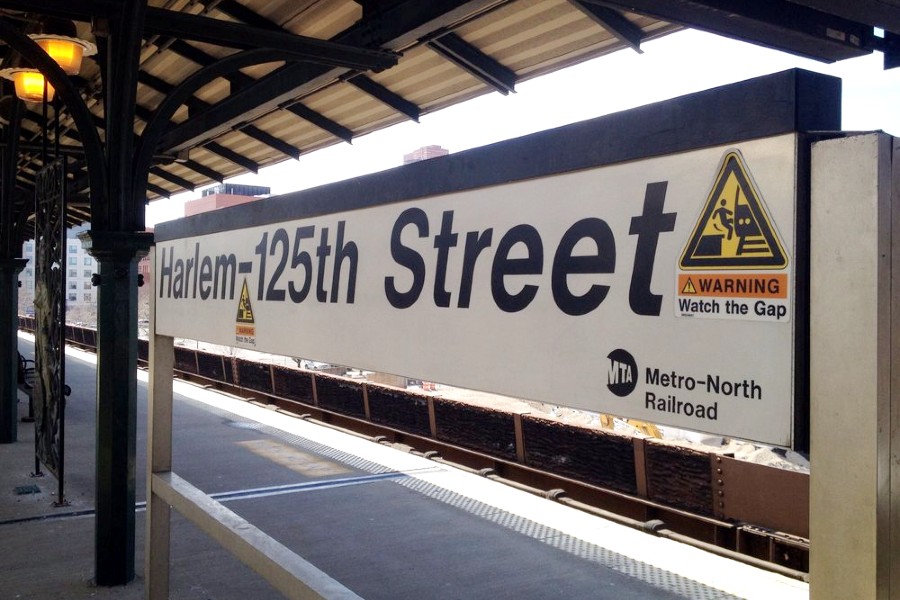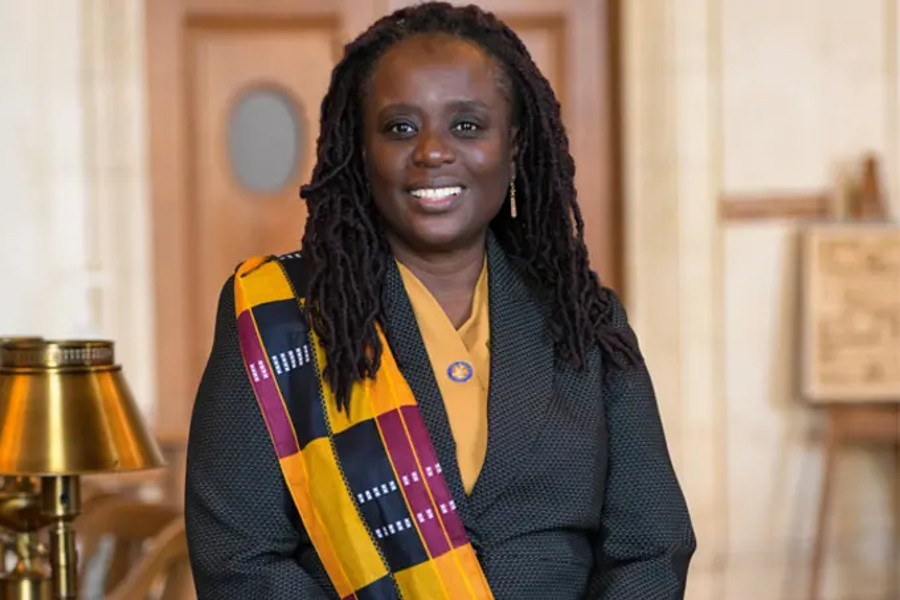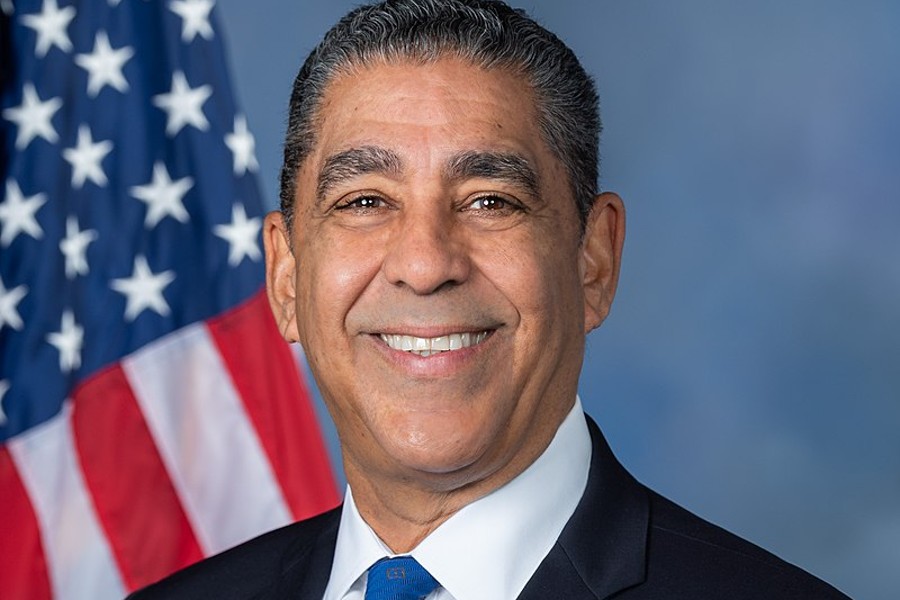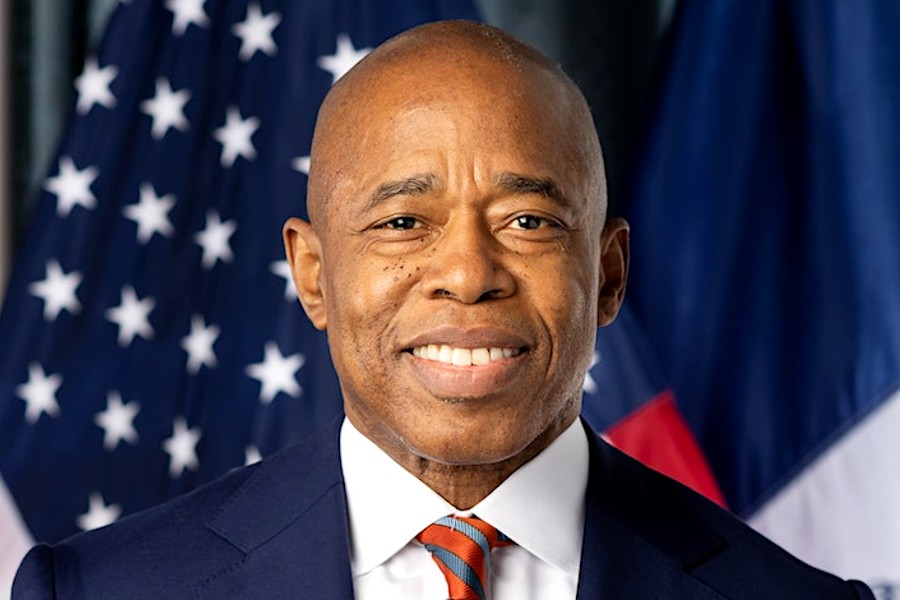
New York City Mayor Eric Adams, New York City Economic Development Corporation (NYCEDC) President and CEO Andrew Kimball.
This includes Mayor’s Office of Talent and Workforce Development (NYCTalent) Executive Director Abby Jo Sigal today announced the release of the Green Economy Action Plan — a first-of-its-kind plan that lays out a roadmap to growing the city’s green economy. The plan invests in jobs and sectors that will help the city combat climate change, and train and position New Yorkers — particularly those from environmentally-disadvantaged communities — to benefit from the nearly 400,000 projected ‘green-collar’ jobs in New York City by 2040.
Critical to this plan is the creation of a new “Climate Innovation Hub” at the Brooklyn Army Terminal, which will help grow green technology startups and businesses, and which will be joined together with the Trust for Governors Island and the Brooklyn Navy Yard Development Corporation to create a green economy ecosystem across three campuses that will support 5,000 new permanent jobs, educate and train 2,100 New Yorkers, and generate $55 billion of economic impact. The Green Economy Action Plan delivers on another promise in Mayor Adams’ State of the City address, and builds on his commitment to invest in future-focused industries and create a “Harbor of the Future” with job and innovation hubs along the East River.
“Our city didn’t recover the nearly 1 million jobs we lost during the pandemic and reach a new private-sector job high by looking backward — we did it by building an economy of the future. And we must draw on all our resources to protect our city from the effects of climate change,” said Mayor Adams. “From building resiliency projects and retrofitting apartment buildings, to installing solar panels, EV charging stations, and wind turbines, ‘green-collar’ jobs are already in demand and leading the way. Our Green Economy Action Plan will harness the growth of a new kind of industrial revolution and give New Yorkers the tools they need to build a resilient and prosperous city and thrive in our future-focused economy.”
The Green Economy Action Plan delivers the first forecasting of New York City’s green economy and job growth through 2040. New York City’s green economy will host nearly 400,000 jobs by 2040 — up from 133,000 today — as it becomes the anchor of a prosperous, equitable, and just future for New Yorkers, while it simultaneously advances the city’s ambitious goals to reduce the city’s threats due to climate change. The plan identifies key occupations that are essential to growing the green economy and highlights 21 occupations that provide pathways to economic mobility, many of which do not require higher education degrees.
Highlights of the plan include:
- Establishing a Climate Innovation Hub: NYCEDC will invest up to $100 million to develop a Climate Innovation Hub at the Brooklyn Army Terminal. This new space will accelerate commercialization pathways for climate tech startups and other green economy businesses. It will serve 150 startups over 10 years — generating $2.6 billion in economic impact and creating 600 jobs — while providing local workforce training and job placement, particularly for the local Sunset Park community.
- Creating Green Training Facilities in Every Borough: NYCTalent — in partnership with other city agencies, as well as private partners — will develop a workforce training facility in every borough with programming to train New Yorkers for green-collar jobs. The plan will deliver more than 12,000 green economy apprenticeships by 2040 through efforts such as a green building and construction workforce pilot program on Governors Island to train more than 100 people per year for the first two years.
- Activating a Harbor Climate Collaborative: The Brooklyn Navy Yard, NYCEDC, and the Trust for Governors Island are collectively investing $725 million to build a green economy ecosystem across 6-million-square-feet and 72 acres linked by NYC Ferry across New York Harbor. The collaborative will catalyze climate education, research, innovation, commercialization, and workforce development alongside partners from the private and nonprofit sectors. This work will build on a strong foundation of green economy projects such as the 400,000-square-foot New York Climate Exchange, an academic and research consortium anchored by Stony Brook University on Governors Island, and the development of 5-million-square-feet of net-zero manufacturing space at the Brooklyn Navy Yard.
- Activating Public Sites for Electric Vehicle (EV) Charging: NYCEDC is activating two acres of land near JFK airport to create the largest EV charging facility in the city, with 65 public EV chargers including 12 rapid ones. The facility is currently estimated to charge 1,000 vehicles per year, with potential for growth depending on market demand. The Brooklyn Navy Yard is also installing over 80 EV chargers across its 300-acre campus, including infrastructure for commercial fleet charging and a dedicated public lot for neighboring residents. Together, these investments constitute some of the largest investments in EV infrastructure in outer borough job centers in New York City to date.
- Creating Tax Incentives for Battery Storage: NYCEDC will utilize New York City’s Industrial Development Agency tax incentives to activate 500 Megawatts (MW) of battery storage capacity and support other green economy uses. To date, the Industrial Development Agency has induced 200MW of storage capacity that is expected to come online in the coming years and generated nearly $500 million of private sector investment. Unlocking additional storage capacity will ultimately drive a stronger and more efficient renewable energy sector.
“The Green Economy Action Plan is an integrated talent and economic development strategy for the five boroughs and another example of the Adams administration’s work connecting New Yorkers to family-sustaining jobs, spurring inclusive economic activity in high-growth sectors and marshaling a coordinated, citywide response to climate change,” said Deputy Mayor for Housing, Economic, and Workforce Development Maria Torres-Springer. “I am excited to be a part of this historic release and eager to join with New Yorkers, my colleagues in government, and partners in the private sector to create the world’s most dynamic and equitable green ecosystem right here in New York.”
“Treating the climate change crisis with the urgency it requires doesn’t just support our infrastructure but our economy too, with good, ‘green-collar’ jobs for New Yorkers with diverse educations and histories,” said Deputy Mayor for Operations Meera Joshi. “As unusual weather events become all too usual, we all have a role to play in protecting our city. Our city is creating the framework so that everyone can get involved.”
“This first-of-its-kind plan lays out a series of commitments and strategies that will bolster economic growth, create thousands of jobs, encourage public-private partnerships, and ensure a just transition to a green economy that all New Yorkers can contribute to and benefit from,” said NYCEDC President & CEO Kimball. “There is no better location for innovation than at the historic Brooklyn Army Terminal, located on the waterfront in the heart of Sunset Park, which is turning into a center for clean tech innovation and manufacturing. Climate tech growth at the Brooklyn Army Terminal will be further catalyzed by the establishment of the Climate Innovation Hub and through a unique partnership with the Brooklyn Navy Yard and the Trust for Governors Island, known as the Harbor Climate Collaborative. Collectively, these three remarkable city assets, all connected by a short NYC Ferry ride, will be at the forefront of climate innovation, commercialization, and workforce development for decades to come.”
“By co-authoring the Green Economy Action Plan, we wrote the roadmap for an historic opportunity to tackle the climate crisis, create jobs, and drive economic mobility, while positioning New York City as a global leader in the green economy,” said NYCTalent Executive Director Sigal. “The plan represents the city’s commitment to concrete strategies to ensure that all New Yorkers contribute to and benefit from our city’s growth and prosperity.”
“The Brooklyn Navy Yard is proud to be an integral partner in making New York a global destination for climate adaptation and technology development and production, and to further build on the growing community of climate solutions companies already thriving at the Yard,” said Brooklyn Navy Yard Development Corporation President and CEO Lindsay Greene. “New York City is uniquely positioned to take on this challenge, and through strategic investments in promising climate tech, we can benefit from the silver lining that is a flourishing green economy that propels New Yorkers into sustainable career paths.”
“Preparing our city for climate change will require transformative collaboration and opportunities to rapidly scale solutions that benefit all New Yorkers, and the Green Economy Action Plan outlines a necessary roadmap,” said Trust for Governors Island President and CEO Clare Newman. “Governors Island is an exciting platform for a growing ecosystem of partners, including the New York Climate Exchange, that are advancing research, education, training, and public programs, and we’re proud to join our colleagues in furthering New York City ‘s role as a global leader in developing equitable solutions to climate change.”
“Reducing our contributions to climate change and building the infrastructure that will make us more resilient to extreme weather represents an historic opportunity to grow and broaden our economy and workforce,” said New York City Chief Climate Officer and New York City Department of Environmental Protection Commissioner Rohit T. Aggarwala. “As laid out in ‘PlaNYC,’ with the proper planning and guidance, we can help ensure that all New Yorkers are able to benefit from this once-in-a-generation opportunity.”
“As New York City makes historic investments in climate, it’s imperative that we bring everyone along,” said Mayor’s Office of Climate & Environmental Justice Executive Director Elijah Hutchinson. “Environmental justice and workforce champions know that we now have to do the hard work of making these job opportunities real for everyday New Yorkers. In tandem with apprenticeships, workforce training, local job placement, and the contribution of crucial environmental-justice advocacy groups like UPROSE, Green City Force, and the HOPE Program, this action plan advances a more just climate transition for New Yorkers.”
Through a Request for Proposal to be released on March 18, 2024, NYCEDC will seek an operator for its new Climate Innovation Hub at the Brooklyn Army Terminal. Potential partners can learn more about the vision for the hub and complete a partner form to register interest.
Climate technology companies are a particularly bright spot within New York City’s green business landscape. As of 2022, the New York City metropolitan area is the third largest climate tech ecosystem in the country with 179 active climate tech companies and venture capital investments, reaching almost $4 billion in 2021. This opportunity is turbocharged by over $2 billion in venture capital funding flowing to New York City’s climate tech sector since 2021, a 400 percent spike over the $500 million in investment from 2018 to 2020; ambitious city and state climate policy targets; and over $500 billion in public funding being made available at the state and federal levels to support the nation’s shift to a green economy.
The Green Economy Action Plan deliver on a key commitment in Mayor Adams’ “PlaNYC: Getting Sustainability Done” plan, New York’s long-term strategic climate plan. The Green Economy Action Plan also builds on decades-long work led by advocacy environmental groups, including UPROSE, whose Green Resilient Industrial District (GRID) Plan and ‘The GRID 2.0” provide a comprehensive, community-led path to decarbonize Sunset Park and ensure a just transition towards a greener and cleaner future.
“The Green Economy Action Plan demonstrates our administration’s commitment to ensuring that all New Yorkers can contribute to and benefit from a resilient and strong New York City,” said Mayor’s Office of Food Policy Executive Director Kate MacKenzie. “We are proud to be part of a city investing in climate-resilient systems and solutions, including sustainable food distribution, production, consumption, and disposal. The plan lays out how we can continue to engage the private sector in meeting our ambitious climate goals through the city’s Plant-Powered Carbon Challenge, work towards decarbonization of food distribution, and support sustainable food businesses and practices.”
“The Green Economy Action Plan is truly a win-win for New Yorkers,” said New York City Department of City Planning Director Dan Garodnick. “By creating good-paying green industry jobs and bolstering energy-efficient tech throughout the five boroughs, we’re keeping our city on the cutting edge of innovation and a more sustainable path. Thanks to policies like this and ‘City of Yes for Carbon Neutrality,’ we’re well on our way to a greener, healthier, more prosperous future.”
“Realizing a more sustainable and equitable transportation future entails dedicated investments in environmentally friendly initiatives and infrastructure throughout all five boroughs,” said New York City Department of Transportation Commissioner Ydanis Rodriguez. “DOT is proud to contribute to the Green Economy Action Plan, including through our green freight, electric vehicle charging, and shared mobility programming, which foster green job opportunities for New Yorkers and propel the city towards achieving ambitious climate action goals.”
“Today marks a pivotal moment in our city’s commitment toward building a more sustainable future for all New Yorkers. With the unveiling of the Green Economy Action Plan, we are not only making strides toward combating the impacts of climate change, but we are also laying the foundation for equitable economic growth,” said New York City’s Department of Buildings Commissioner Jimmy Oddo. “The Climate Innovation Hub at the Brooklyn Army Terminal, in particular, will help foster green technology startups, which are going to be critical as larger property owners work to reduce carbon emissions from their buildings.”
“Through the Green Economy Action Plan, we’re doubling down on our commitment to environmental justice and equitable workforce development, as we simultaneously embrace the challenge of climate change,” said New York City Department of Citywide Administration Commissioner Dawn M. Pinnock. “We are thrilled to be part of this important effort as we work together to make sure everyone gets a fair shot at a better, greener future.”
“New York City is and must continue to be a global leader in the fight against climate change. With the city’s Green Economy Action Plan as our guide, we now have a clear roadmap to build a resilient, green economy in preparing for the economic and environmental realities of what’s to come,” said Dr. Stephen Hammer, CEO, New York Climate Exchange. “The Exchange and our partners are thrilled to be part of this endeavor. We look forward to working with City Hall, entrepreneurs, community organizations, and the financial sector to identify and promote jobs for both low- and high-skilled workers that help the city meet its climate adaptation and mitigation goals.”
In April 2023, the Adams administration, Governors Island, and the State University of New York Stony Brook University unveiled the “New York Climate Exchange,” a transformative vision for a first-in-the-nation climate research, education, and jobs hub on Governors Island that will create thousands of permanent jobs and $1 billion in economic impact for the city. The Exchange will establish a cross-sector consortium of over 45 partner organizations, representing leading universities, businesses, and non-profit organizations, and will develop a state-of-the-art, $700-million, 400,000-square-foot campus dedicated to researching and developing innovative climate solutions that will be scaled across New York City and equip New Yorkers for green-collar jobs of the future.
Sunset Park in South Brooklyn continues to be an emerging hub for climate innovation. In March 2022, Mayor Adams announced an agreement to transform the city owned South Brooklyn Marine Terminal (SBMT) into one of the largest offshore wind port facilities in the nation. The world-class offshore wind hub at South Brooklyn Marine Terminal is projected to support the buildout, management, and interconnection of electricity generation for more than 2 million homes. Last September, NYCEDC launched Pilots at the Brooklyn Army Terminal, a climate innovation pilot program allowing companies to test and scale their technologies in live environments.
“The future of New York’s economy and of American jobs is in green infrastructure,” said U.S. Representative Dan Goldman. “I’m thrilled to see our city preparing for and embracing this green energy future by investing in jobs that will help our city combat climate change and mitigate future extreme weather events. While we must ensure that community voices are front and center while this plan is implemented, this critically important investment and training will ensure that our economy is competitive and prepared for years to come.”
“The historic Green Economy Action Plan is the roadmap to an economy laser-focused on sustainability, resilience, and financial empowerment. This first-of-its-kind plan utilizes a $100 million investment in the ‘Climate Innovation Hub’ at Brooklyn Army Terminal to create thousands of jobs and apprenticeships in fields that tackle climate change head-on,” said New York State Assemblymember Jenifer Rajkumar. “It will supercharge our economy, producing 400,000 green collar jobs and generating an economic impact of $55 billion. It puts us on the path to New York City becoming the leader in green collar jobs and the green economy of the future.”
“We must do everything in our power to reverse the impact of climate change on our planet. The time for half measures is over,” said New York State Assemblymember Jo Anne Simon. “I’m encouraged to see that New York City is taking bold action to grow the city’s green economy and invest in green jobs, especially at centers of innovation like the Brooklyn Navy Yard. Thanks to Mayor Adams for his commitment to protecting our planet for future generations.”
“As New York City’s green economy grows, it is critically important to develop a highly skilled workforce and create pipelines to family-sustaining union careers for all New Yorkers interested in entering the industry,” said Gary LaBarbera, president, Building and Construction Trades Council of Greater New York (BCTC). “The Green Economy Action Plan highlights union apprenticeship programs that commit to building a sustainable workforce that will meet labor demands and propel us towards our clean energy goals. BCTC is looking forward to working alongside New York City leadership to increase these opportunities, provide economic mobility and ensure that New Yorkers are meaningfully included high-quality, green collar union jobs.”
“Green City Force (GCF) is excited to participate in the announcement of the Green Economy Action Plan. This investment is a significant move towards a #futuregreencity rooted in environmental, economic, and social justice,” said Tonya Gayle, executive director, Green City Force. “This plan fully aligns with GCF’s priorities: tapping and supporting the inspired potential of young leaders to power and lead a green and inclusive economy through service in sustainability.”
“With more than 40 years of dedicated service to the Brooklyn community, Opportunities for a Better Tomorrow has been at the forefront of cultivating a skilled and diverse workforce through its employment and educational services,” said Evelyn Ortiz and Greg Rideout, co-chief executive officers, Opportunities for a Better Tomorrow. “We are thrilled to collaborate with the mayoral administration and the New York City Economic Development Corporation on their Green Economy Action Plan to address the anticipated four-fold increase in green economy jobs over the next 15 years, with a strong focus on community hiring. This commitment reinforces our shared dedication to sustainable economic growth and equity, while also addressing the city’s challenges related to climate change.”
“The Green Economy Action Plan demonstrates New York City’s continued commitment to be a national leader of the Green Jobs sector at a scale that will both meet the growing climate crisis and bring economic empowerment in a sector that is steadily growing by over 8% per year,” said Tracey Capers, executive director, The HOPE Program. “The HOPE Program, which provides Green Job career training and links to employment in communities most affected by environmental racism, applauds the expertise and opportunities that this plan will bring. Every New Yorker will benefit from this investment that will allow our city to be greener, healthier, and energy efficient for long-term sustainability.”
“Plumbing in general, and specifically the production and delivery of domestic hot water for bathing, washing, cooking, and a variety of other uses, is of paramount importance to the safety and comfort of the residents of the City of New York,” said Paul O’Connor, business manager, Plumbers Local Union No. 1 of New York City. “A huge part of the energy consumed in any building is tied directly to domestic hot water supply. As new green technologies are deployed to sustainably continue to provide domestic hot water for our community, this critical work must also create and maintain high quality jobs for New Yorkers. We must plan for a safe and livable New York of the future through a just green transition.”
“FABSCRAP is just one of so many incredible organizations and startups addressing climate change in New York City. I’m very proud to have our work featured in the Green Economy Action Plan. It’s encouraging to see that the City’s planned investment in a more sustainable future includes the creation of equitable jobs, accessible spaces, and networks of support for the most needed innovations,” said FABSCRAP founder & CEO Jessica Schreiber.
“In unveiling his Green Economy Action Plan for NYC, Mayor Adams has taken a bold step towards a sustainable future. The “Climate Innovation Hub” underscores the city’s commitment to environmental stewardship and its dedication to training and expanding the green-collar workforce in New York City,” said Meredith Beckford-Smart, Ph.D., executive director, Genspace NYC. “By investing in future-focused industries and empowering our workforce with the skills for tomorrow’s jobs, Mayor Adams is not just building a greener economy; he is cultivating a more equitable and prosperous future for all New Yorkers.”
“itselectric’s mission is to rapidly scale charging infrastructure needed for the electric vehicle transition in every city and on every block; meeting the needs of private, fleet, and rideshare drivers,” said Tiya Gordon, co-founder and chief operating officer, itselectric. “Our partnership with NYCEDC has become a model for the city to pilot new and innovative technologies with private companies; enabling the collective approach required to achieve New York City’s ambitious climate goals with the crucial principles of speed and scale.”
“The Green Action Economy Plan makes clear that building decarbonization not only cuts emissions but also creates opportunities for green job growth,” said John Mandyck, CEO, Urban Green Council. “Investing in workforce training is key to hitting our city’s carbon reduction targets, and we look forward to leveraging Urban Green’s training expertise to help meet the city’s climate goals.”
“The Division of Workforce Development and Continuing Education at Kingsborough Community College (KCC), CUNY, commends and wholeheartedly supports the Green Economy Action Plan for its efforts in establishing infrastructure and programs aimed at equipping New York communities with the necessary training to cultivate the next generation of clean energy professionals,” said Christine Zagari-LoPorto, associate dean, KCC Division of Workforce Development and Continuing Education. “The allocation towards the Climate Innovation Hub will support the establishment of an educational center and assist in identifying talent from historically underrepresented communities, ensuring that all New Yorkers can access these benefits, mirroring our efforts at KCC within the Maritime industry and Offshore Wind. We eagerly anticipate its transformation into a cornerstone for training, employment, and innovation.”
“Mayor Adams and his administration has championed a green economy since he took office two years ago. Today’s announcement is an important and necessary investment in building Brooklyn’s economic development,” said Randy Peers, president and CEO, Brooklyn Chamber of Commerce. “The new “Climate Innovative Hub” will not only bring new jobs to Brooklyn, but it will provide necessary skills and education to historically marginalized communities. This is a big win for the future of Brooklyn and all of New York City.”
“With the support of Mayor Adams and NYCEDC, the members of Local Union No. 3, IBEW look forward to continuing and strengthening our role in the growing green economy in New York City in support of the “Green Economy Action Plan”, working on the transition necessary to address the climate crisis,” said Christopher Erikson, business manager, Local Union No. 3, International Brotherhood of Electrical Workers. “In alignment with the Mayor and EDC, we believe these green jobs of the future should be union jobs with family-sustaining wages and benefits, and as the work opportunity expands, we look to welcome more apprentices supported by this plan into our ranks, making New York City a better place to live and work.”
“The green economy has the potential to be a major new engine of middle-class job growth in New York City, so it’s great to see this comprehensive plan to help the city take full advantage of this opportunity and ensure that a large share of the new jobs go to New Yorkers from environmentally-disadvantaged communities,” said Jonathan Bowles, executive director, Center for an Urban Future. “Mayor Adams, NYCEDC, and NYCTalent deserve a lot of credit for getting ahead of this emerging part of the city’s economy and building career pipelines for New Yorkers from low-income backgrounds into the well-paying green jobs that will be created.”
“The release of the Green Economy Action Plan marks a significant milestone in advancing New York City’s commitment to combat climate change and foster economic growth,” said Jelena Kovačević, dean, NYU Tandon School of Engineering. “I’m excited about the plan’s focus on sustainability, climate tech startups, and the creation of a collaborative ecosystem, which aligns with our Sustainable Engineering Initiative mission and positions the city as a hub for green innovation, education, and job creation.”
“Matching New York’s ground-breaking leadership in climate action legislation will require an equally innovative initiative to train and up-skill our workforce,” said Richard C. Yancey, FAIA, LEED AP, executive director, Building Energy Exchange. “The Green Economy Action Plan is critical to unlocking New York’s talent and innovation, delivering on the promise of a green collar workforce, while creating thousands of jobs to reduce the threat of climate change.”
“The Green Economy Action Plan represents the future of a resilient, sustainable, and equitable New York. At Streetlife, we are thrilled to be a part of this story and excited to work with the city’s test bed network to help early-stage startups bring their urban climate solutions to life,” said Sonam Velani, co-founder and managing partner, Streetlife Ventures.
“NineDot Energy is excited to support Mayor Adams’ Green Economy Plan” said Adam Cohen, co-founder and chief technology officer, NineDot. “Our company was created to improve access to cleaner energy, enable a more stable grid, and bring environmental justice results to impacted city neighborhoods. We look forward to partnering with NYCEDC and sister agencies to advance our battery storage and other clean energy projects, all while increasing jobs and supporting green economy workforce initiatives for underserved New Yorkers. As a business started and headquartered in Brooklyn, with a growing employee base centered in the city, we applaud all the mayor’s efforts to make New York cleaner and greener, from this plan, to the City of Yes for Carbon Neutrality, to the Zero Emissions Vehicle mandate, and more.”
“Our climate future is dependent on developing a clean energy economy that works for everyone, regardless of their zip-code, skin color, or socioeconomic status,” said Alia Soomro, deputy director for NYC policy, New York League of Conservation Voters. “As new ways of building are implemented, new technologies come online, and cleaner modes of transportation grow to scale, there is a huge opportunity to center our workforce pipeline around communities who have suffered the most from decades of short-sighted environmental policies, and that is exactly what Mayor Adams’ Green Economy Action Plan will do.”

“Equinor applauds Mayor Adams and the New York City Economic Development Corporation on their Green Economy Action Plan and the significant investments they are making to New York City’s green economy,” said Molly Morris, president, Equinor Renewables Americas. “New York City is paving the way in climate leadership and the pursuit of environmental justice for disadvantaged communities. In support of this, we are proud to be a partner with New York City on the revitalization of the South Brooklyn Marine Terminal.”
“The Green Economy Network and JobsFirstNYCapplaud New York City Mayor Eric Adams, NYCEDC, and NYCTalent for unveiling the Green Economy Action Plan, a visionary roadmap for the city’s sustainable future. Most notably, the mayor’s plan centers equity, employment, and economic growth, and we are committed to collaborating with the administration and citywide partners to ensure the success of this plan,” said Keri Faulhaber, vice president, JobsFirstNYC. “Together, we can pave the way for a resilient and inclusive green economy, creating opportunities for New Yorkers, especially those in environmentally-disadvantaged communities, to thrive in the nearly 400,000 green collar jobs projected by 2040.”
“The Green Economy Action Plan is a groundbreaking initiative that will propel New York City to the forefront of the global green economy and ensure a more sustainable future for all New Yorkers,” said Carlo A. Scissura, Esq., president and CEO, New York Building Congress. “By committing to the creation of nearly 400,000 green collar jobs by 2040 and a $100 million Climate Innovation Hub, we are not just investing in the environment, we are investing in our people and our collective future.”
Become a Harlem Insider!
By submitting this form, you are consenting to receive marketing emails from: Harlem World Magazine, 2521 1/2 west 42nd street, Los Angeles, CA, 90008, https://www.harlemworldmagazine.com. You can revoke your consent to receive emails at any time by using the SafeUnsubscribe® link, found at the bottom of every email. Emails are serviced by Constant Contact



